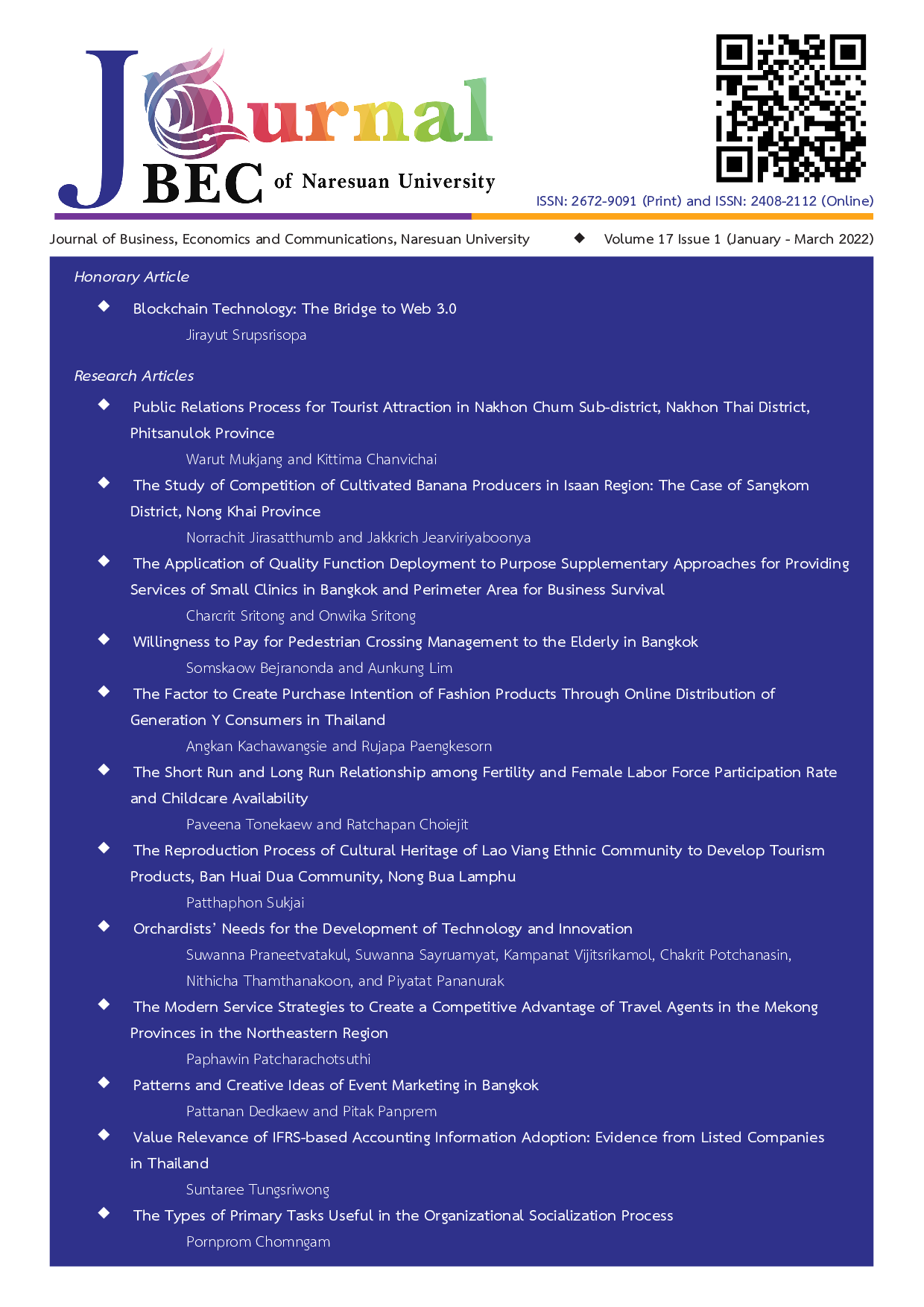The Reproduction Process of Cultural Heritage of Lao Viang Ethnic Community to Develop Tourism Products, Ban Huai Dua Community, Nong Bua Lamphu
Main Article Content
บทคัดย่อ
The objectives of this research were to: 1) survey cultural heritage of Lao Vieng ethnic community, Ban Huai Duea, Nong Bua Lamphu; and; 2) synthesize reproduction process of cultural heritage of Lao Vieng ethnic community, Ban Huai Duea, Nong Bua Lamphu. This research was a qualitative research. The research tools included in-depth interview, participatory observation and non-participatory observation. The key informants were 45 cases of local scholars, community leaders, community members, youths and representatives of public sector and local administration organization. The data triangulation was applied with several data sources. The content analysis was used for data analysis and proposed with description. The results proved that:
People living in Ban Huai Duea community are Lao Vieng ethnic group that migrated from Lao’s Vientiane between late Thonburi period and early Rattanakosin period. Since then, they brought tools, utensils, culture, traditions, beliefs and rituals with them. As a result, they have unique identity, especially culture and art, handicraft, language, tradition and lifestyle. The potential community identity is possible to be developed as tourism product through cultural heritage reproduction process, comprising: 1) Research; 2) Knowledge Management; 3) Conservation; 4) Restoration; 5) Inheritance; and 6) Creativity. It can be further developed to creative economy based on Lao Vieng ethnic cultural heritage, which is critical cultural capital toward sustainable cultural tourism community.
Article Details

อนุญาตภายใต้เงื่อนไข Creative Commons Attribution-NonCommercial-NoDerivatives 4.0 International License.
เอกสารอ้างอิง
Aaker, D. A. (2001). Strategic market management. New York: John Wiley; p. 154
Aksornpim, J. (2017) Strategy management of community-based tourism towards the sustainable in nakhonratchasima. Journal Research and development of Valaya Alongkorn under Royal Patronage. 12(3), 141-154.
Bourdieu, P. (1993). The field of cultural production. Cambridge, England: Polity Press, p.12
Cohen, A. (1974). Introduction: The lesson of ethnicity. In A. Cohen (Ed.). Urban ethnicity. (pp. 1-17). London: Tavistock.
Department of Cultural Promotion. (2011). National Culture Act 2010. Retrieved January 20, 2020, from https://www.m-culture.go.th/en/index.php.
Department of Tourism Economy. (2016). Tourism Economic Conditions Report. Ministry of Tourism and Sports. Bangkok, Thailand
Dictionary of Sociological Terms. (2006). 3rd rev. ed. Bangkok: The Royal Institute. [In Thai]
Ganjanapan, A. (2008). Multiculturalism in the context of social and cultural change. Chiang Mai: Chiang Mai University. (in Thai).
Griswold, W. (2004). Cultures and Societies in a Changing World. Thousand Oaks: Pine Forge Press
Jintananon, P. and Sirikutta, S. (2014) Motivation and Hygiene Factors Corporate Culture related to the Organizational Commitment of the Government Officers Working in the Government Revenue Office in Nakhon Pathom Area, Srinakharinwirot Journal of Business Administration. 5(1), pp. 116-138.
Kaewthep, K. and Hinwiman, S. (2008) The political economic theorists and communication studies. p. 67
Lertschanrit, T. (2016). Cultural Resource Management. Bangkok: Sirindhorn Humanities Center. pp. 72-90
Malahom, C. (2012). Community identity, foundation for education. Journal of Education Rajabhat University Mahasarakham. 9(1), 41-43.
Na-Thalang, A. (2001). Overview of Thai wisdom. Bangkok: Amarin printing publishing, p. 112
Office of the National Economic and Social Development Board. (2016). Summary of Development Plan National Economy and Society The twelfth edition 2017-2021. Bangkok: Office of the National Economic and Social Development Board, the Prime Minister's Office, p.103.
Pongsapich, A. (1998). Cultures, religions and ethnics: Analysis of Thai society using anthropological concept. (5th ed.) Bangkok: Chulalongkorn University Press. pp.70-73 [In Thai]
Srisantisuk, S. (1996). Principles of qualitative research with ethnic communities. Journal of Language and Culture, 15(2), 4-13. [In Thai]
Small and Medium Enterprises Development Institute. (2018). Value added services and product design. Retrieved January 20, 2020,
from http://www.ismed.or.th.
Soonthorncharoen, Warunee. (2017). Create a product or service that is not difficult to imagine. Retrieved January 20, 2020, from http://www.amexteam.com/resources/helper/editor/upload/knowledge/1/01_.pdf
Thinkham, Y., (2017). Culture and Change: Diversity on Diversity. Retrieved October 17, 2019, from http://smf.sdmkku.com/index.php?topic= 65.0.
Uracha, W. et al. (2019). The relationship between culture, food liking, and body mass index in Australian and Thai young adults. Asia Pacific Journal of Clinical Nutrition, 28(3), pp. 634-644.
Vinitjakul, T. (2012). The origin of Siam from the map: the history of the nation's landscape. Bangkok: Project to print torch. pp. 57-65
Wallipodom, S. (2013). Nan Reservoir: Cultural Landscape of Ban Pang Muang. Journal of Ancient City, 40(1), pp. 25-37.
Wanlam, D. (2009). The development of the concept of reconciliation culture of a multicultural society as per the views of border patrol police with experience in working in the three southern border provinces (Research report). Songkhla: Thaksin University. (in Thai).


